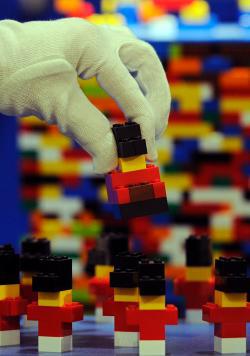It’s been a big week for the debate over gender and children’s toys. On Wednesday, the British toy purveyor Hamleys announced its decision to desegregate its offerings (which had previously been arranged in sections for boys and girls), instead opting to categorize them by type. Activists working for the spread of gender neutrality were thrilled; but, predictably, conservative commentators immediately cried foul, trotting out the old essentialist idea that “nature will always trump nurture and any attempt to re-educate children so they grow up to be model citizens in some socialist utopia is bound to fail.” On the same day, the Dutch toy-making powerhouse Lego announced that in 2012 it would roll out a new, girl-specific line of the classic building-block kits, called Lego Friends.
Bloomberg Businessweek has a fascinating piece on the development of the new kits, which explains the lengthy and in-depth anthropological study the company mounted in order to identify the differences in how girls and boys play.
Lego confirmed that girls favor role-play, but they also love to build—just not the same way as boys. Whereas boys tend to be “linear”—building rapidly, even against the clock, to finish a kit so it looks just like what’s on the box—girls prefer “stops along the way,” and to begin storytelling and rearranging.
These results led Lego designers to create an imaginary world called Heartlake City in which players can follow a cast of female characters—each with a back-story and personality (for example, Emma the Beautician and Olivia the Smart Girl)—as they go about their lives.
While I’m a disappointed that only one of the girls is being sold as “smart,” I have to concede that it seems like Lego did their homework on this one. The BW article reports that the designers were well-aware of the danger of perpetuating pink-washed gender stereotypes, but felt that luring girls to build and play with the brain-stimulating blocks was worth the risk. After all, culturally conditioned preferences for certain colors and styles are unfortunately instilled long before kids get to the recommended start age of 6 anyway. Why not use them to entice girls into a kind of intelligence-boosting play that they might not otherwise experience?
Even better, though, would be if toy-selling stores followed Hamelys’ lead and stopped separating gendered toys by aisle. Target has already said that it will not present the new Lego line with the rest of the company’s kits, but in the girl’s section instead. Keeping all the Legos together would allow for a kind of border-crossing, mish-mashy play that would be healthy for all kids, regardless of gender. Imagine the excitement of having your idyllic Heartlake City invaded by Star Wars Storm Troopers or of sending Emma on a mission to beautify some construction workers. Maybe this vision of subversive mixing is a “socialist utopian” dream, but it sure sounds like a lot of fun to me.
